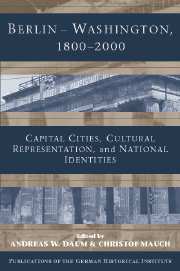Book contents
- Frontmatter
- PART I CITIES AS CAPITALS ON A GLOBAL SCALE
- PART II THE CAPITAL IN THE NATION
- PART III ARCHITECTURE, MEMORY, SPACE
- 6 State, Volk, and Monumental Architecture in Nazi-Era Berlin
- 7 Monuments of Catastrophe: Holocaust Architecture in Washington and Berlin
- 8 Capital Gardens: The Mall and the Tiergarten in Comparative Perspective
- 9 Socialism on Display: East Berlin as a Capital
- PART IV POLITICAL POWER AND CAPITAL FUNCTIONS
- Index
7 - Monuments of Catastrophe: Holocaust Architecture in Washington and Berlin
Published online by Cambridge University Press: 05 January 2013
- Frontmatter
- PART I CITIES AS CAPITALS ON A GLOBAL SCALE
- PART II THE CAPITAL IN THE NATION
- PART III ARCHITECTURE, MEMORY, SPACE
- 6 State, Volk, and Monumental Architecture in Nazi-Era Berlin
- 7 Monuments of Catastrophe: Holocaust Architecture in Washington and Berlin
- 8 Capital Gardens: The Mall and the Tiergarten in Comparative Perspective
- 9 Socialism on Display: East Berlin as a Capital
- PART IV POLITICAL POWER AND CAPITAL FUNCTIONS
- Index
Summary
Lektor, si monumentum requiris, circumspice.
(Epitaph of Sir Christopher Wren in St. Paul's Cathedral, London)Es ist niemals ein Dokument der Kultur, ohne zugleich ein solches der Barbarei zu sein.
Walter Benjamin (cited by Jochen Gerz in his competition entry for the Berlin Holocaust Memorial)CITIES AND MEMORY
Metropolitan memory is the “deepest structure” of architecture. In the words of the late postmodern architect Aldo Rossi, “the city is the locus of the collective memory” of its people; “as certain artifacts become part of its memory, new ones emerge.” For a nation's capital, this aspect of psychic-spatial accrual is paramount. Over time, our national monuments are conceived of and grow - or are shed and discarded - just like the objects of our consciousness. Here, Rossi is developing the theory of spatially induced social memory first proposed by the Durkheimian French sociologist Maurice Halbwachs (who died at Buchenwald in 1945). It is to Halbwachs that we owe the insight that memory is not, in fact, created in a purely individualistic way, except in the Freudian dreamwork; during waking hours, collective “frameworks” (whether language-, family-, class-, race-, or place-based) are necessary to provide pressure and guidance in individual memory-formation; indeed, entire systematic must be made in the present, and these “landmarks” are perception-based in nature. Rossi’s application of Halbwachs’ thesis onto the realm of architecture demonstrates how there is an ongoing dialectical union between people and the urban spaces they are transforming and being transformed by; as Rossi states, “memory becomes the guiding thread of the entire complex urban structure.”
In this way, we store our public memory (our heritage) in our cities’ edifices – not only in historical or commemorative monuments per se but in various structures of urban achievement such as skyscrapers, bridges, airports, and train stations – all of which proceed to mold not just our group identities but also how we conceptualize the metropolis. Monuments can evolve accidentally or can be instilled from the outset with a sense of permanence, a condition that art historian Alois Riegl referred to a hundred years ago as an act of “art-volition” (Kunstwollen). In the case of Washington, D.C., we witness an entire federal city that was designed as a classical monument – as if it were, indeed, an ancient Greek or Roman city, or even a tourist-oriented “heritage city,” right from the start. Pierre Charles L’Enfant’s 1791 design, invited by George Washington himself, projected grand axes and parklands that would display a collection of pantheons like the Capitol and the White House, all intended to house a highly disparate nation around the unifying vista of the Mall. Admittedly, these plans took more than an entire century to bring to fruition, with the belated completion of the Washington Monument in 1884, and the eventual resurrection and expansion of L’Enfant’s by-then forgotten concept for the Mall by a commission (the McMillan Plan of 1901) that included Daniel Hudson Burnham, the organizer of the 1893 Chicago World’s Columbian Exposition, and Frederick Law Olmsted, Jr., the son of Central Park’s designer.
- Type
- Chapter
- Information
- Berlin - Washington, 1800–2000Capital Cities, Cultural Representation, and National Identities, pp. 155 - 200Publisher: Cambridge University PressPrint publication year: 2005
- 4
- Cited by

